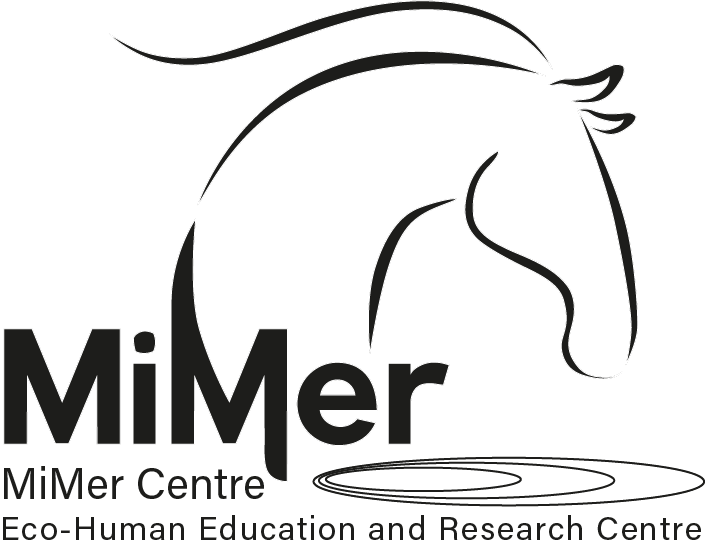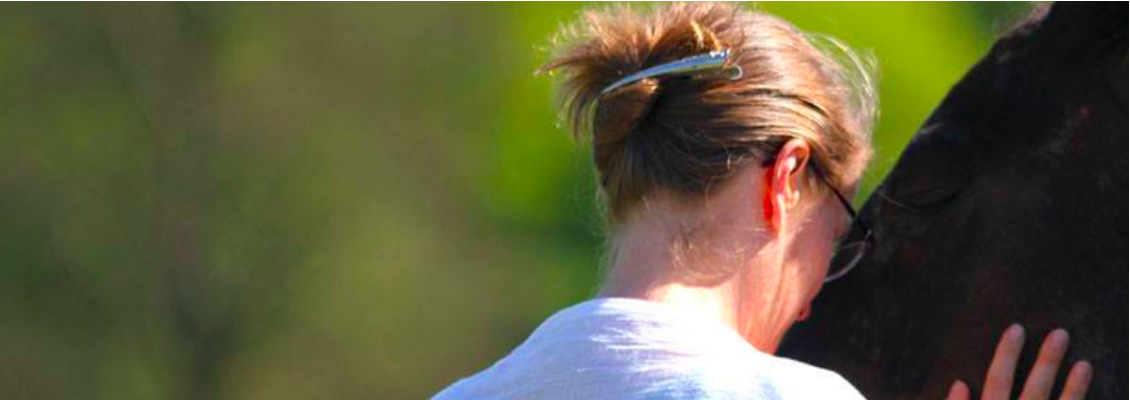When we talk about horses in Equine Assisted Therapies, we are more often concerned with the negative impact meeting clients and dealing with their emotional hardship can have on them, than with the positive impact these meetings can have for their welfare and well-being.
Before I continue.
I'm an avid spokesperson for better equine welfare on all levels. To be able to call it welfare, I think it is necessary for equines to have their biological, as well as their social, emotional and cognitive needs, met. And my welfare standards are set high. So high, I can't reach them myself, for my own horses. But I constantly try to improve my horse-keeping and try to provide my horses with living conditions as close to the ones they would have in a non-captive setting.
This is a list made to inspire us to try to uphold and maintain high standards in our horse-keeping and to help us move from equine welfare to equine well-being (Moving beyond the 5 freedoms and strive for, not only to reach minimum levels of welfare but to actively contribute to well-being and growth for horses). I look at it as a wishing list. I know most of us don't come close to be able to provide this. Never the less, I think it's crucial for us to know what horses need, how they are evolutionary developed to live, so we can aim for improvements and understand the problems that occur when we can't provide our horses with living conditions like this:
- Big home ranges, preferably with different kinds of biotopes and topography. Far exceeding what most people can offer their horses in size and diversity. For the horses to be able to move slowly over big areas most of the day. To have enough space to live without tension in the group (tensions created by space limitations).
- The possibility to graze as many hours as they want per day (in average between 14-18 hours), in a home range that contains and exceed 50 different local plant species.
- The possibility to seek and find shelter (from inclement weather conditions, flies and other insects), to find water and different grazing areas. So they can take care of as many of their own needs as possible and solve their own problems. This gives the horses freedom of choice and agency in their own lives.
- To live in a family band with a natural ratio between females and males. For young males to be able to wander off and form bachelor groups. For young females to be able to join new family bands. For them to be able to procreate, nurse and raise their young ones, to be able to exhibit all their natural behaviors.
- To live lives that take into account the natural changes, and therefore different needs, that occur in different seasons.
This is a list of the biological and social needs of the horse. But what does a horse needs emotionally and cognitively to thrive? I do not think we really can divide between biological, social or emotional and cognitive needs – they are intertwined and dependent on each other. If there is something lacking in one area, there will be effects on the other areas. As with humans. We are holistic beings. But for the sake of the discussion, I will make the distinction and focus on the horses' emotional and cognitive needs. How do we specifically cater to and fulfill their emotional and cognitive needs? What part can Equine Assisted Therapies play in this?
To thrive, a horse, like any other living being, needs to feel a sense of agency. Which means he strives to interact with his environment to learn more about it, to be able to handle it better and better, while developing his skills to master and solve the problems he encounters, so he can meet the future constantly more equipped. He strives not only to master "the here and now" and take care of momentary needs but also to broaden his area of competencies. Every animal is a learning animal. In this learning quest, he needs challenges to overcome. It is through these challenges he learns and grows and has a chance to express agency and develop his functional competencies.
We know that a sense of agency is crucial in humans' lives. It is the basic condition for any human or nonhuman animal's overall well-being, and psychical as well as mental health. What does this mean for a horse working in therapeutic settings, where he is are part of a team, together with a therapist, an Equine Professional and a client (or several) who all work to help the client(s) deal with their psychological issues?
Challenges in the wild that horses are exposed to include finding food, water and shelter, evading predators, finding refuge from bad weather, dealing with illnesses and injuries, and handling social interactions. Their natural environment is both complex and ever-changing, so horses need to adapt and respond to this. They develop competencies, they gather cognitive and behavioral tools and strategies, to meet novel challenges. They need to constantly learn new things, which they do through associative and instrumental learning, inquisitive exploration, social learning, imitation and so on. They acquire a behavioral flexibility. Which they apply in solving both environmental as well as social, emotional or cognitive problems.
Horses interact and communicate with both conspecifics as individuals from other species within their home ecosystem and take part in complex social dynamics and practice observational learning. Problem solving, exploration and play are important components in obtaining agency and competence. All three of them also affects moods. Exploration and problem solving are also intrinsically rewarding and horses like to meet new environments, explore novel objects and situations if they feel safe enough to do so. All horses need appropriate challenges. If the challenge is too big, he will get scared, have a stress reaction, and not learn anything new. If the challenge is too small, he will lose interest, get bored and learn nothing new. A horse needs to encounter challenges containing a balanced, useful level of stress – eustress. This puts him into a learning and growth mode and keeps him intensely engaged through focused attention and sustained concentration, leading to a positive mood. He can experience something that can be likened to the human experience of flow. By initiating and maintaining cycles of cognitive and behavioral effort he experiences a true meaningful state of being.
So agency makes horses happier and psychologically and physiologically healthier. Play, problem-solving and exploration improve physical endurance and sensorimotor coordination and increase neural connections – which is the same as to say it helps the horse to develop behavioral plasticity and increase adaptability.
For horses in captivity, one of the biggest challenges they meet in life is – humans. What do humans represent in a captive horse's life? We represent potential resources, but we can also be/mean a problem, joy, pain, friendship, nuisance, fear, be an incomprehensible factor and so on. Horses meet us in different roles like companion, friend, owner, rider, trainer, breeder, stable owner, veterinarian, other equine health persons, farrier, feeder etc.
If a horse develops more understanding of humans, will this understanding provide him with a higher quality of life? Can he learn about humans, to expand on his human competence? Is it a challenge for him to do so? Will it also give him more agency in his life to do so?
I think so. I think we humans – and the things we expose our horses to, are their main challenge. And since horses are avid learners and are among the most adaptable species on earth, this is what they already are doing. Time to recognize that and help them in this learning process.
What has this to do with Equine Assisted Therapies? Horses need challenges to thrive, well-balanced challenges, that can help them learn about their environment. Humans are a big part of their environment. In Equine Assisted Therapy there can be room for both humans and horses to grow and learn, and to learn about each other. Not necessarily about species-specific behavior (at least not for the client), but about individuality and subjectivity and to have intersubjective and shared experiences that will enhance both clients and horses lives. That will enrich their lives and extend on their competencies and add tools to their toolboxes. That will add understanding of themselves and each other. This will help both client and horse to gain and maintain agency and improve their functional competencies.
It will provide the horses will meaningful work where both he and the client grow. For humans, as for horses, a life without meaningful work and challenges is boring and unfulfilling. It leads to suppressed agency and equals poor equine (and human) welfare and well-being.
In modern horse housing facilities we have to keep our horses in fairly restricted environments. And it is hard to give them room and time for play, exploration and work at the levels they need, to live good lives. Little is novel in their everyday life. Many horses sleep away their days, not out of contentment, but out of boredom and lack of challenges, and in the worst cases, slip into stereotypies and other problematic behavior. Boredom, depression and powerlessness (and learned helplessness) leads to increased levels of fear, anxiety and a reduced ability to cope. We know that horses who live in environment that does not satisfy their needs for movement, social interactions, the possibility to naturally graze and find themselves shelter, water and diverse plants, that is, are living in impoverished environments (as most stable options are, if we look at it from a horse's perspective), heal more slowly and are likely to experience prolonged periods of pain when sick or injured.
To meet a diverse range of people, working to solve social interaction problems, to take part in playful activities that contain problem solving and exploration and to initiate and maintain cognitive and behavioral efforts, will improve equine welfare and well-being. For this, Equine Assisted Therapies can be perfect.
And since the horse and the client are not meeting each other on their own, but have both (ideally) a therapist, an expert on human behavior, and an Equine Professional, an expert on equine behavior, present all the time, to look out for everybody's emotional and physical safety, this must be a true win-win situation for both clients and horses.
This is not to say that horses can not experience too much stress during Equine Assisted Therapy. Or to say that we do not need to look into how anxiety, hostility, fear, projections and other emotions and inter-relational aspects in therapy can negatively impact horses. Or to say that they do not need to spend a lot of time being horses in a stable band of horses in an as good horse environment as we can provide them with.
What I am saying though, is that Equine Assisted Therapy, in my opinion, ought not only to be looked at as a negative experience for horses. But on the contrary, if done and monitored correctly, actually can contribute to better equine welfare and well-being.
This article was inspired by discussions I had with my global colleagues at the Minds-n-Motion 1st International Symposium "A Horse is a Horse of Course" for Equine Welfare and Wellness, as well as from the digital discussions that followed after this symposium, and from reading Marc Bekoff's and Jessica Pierce's book, The Animals Agenda, Freedom, Compassion and Coexistence in the Human Age, 2017, from which I have borrowed ideas and concepts concerning animal welfare in general and then applied it to equine welfare in Equine Assisted Therapies.


Comments